With a focus on continued growth the brand focuses on sustainability and partnerships
As we arrive in 2024, agave spirits had a record breaking year in 2023. One brand that has made its mark is Siete Misterios. The brand was founded by Eduardo Mestre and his brother Julio. They were pioneering in their efforts to bring clay-pot mezcal to the international market, a style that makes up less than one percent of mezcal production.
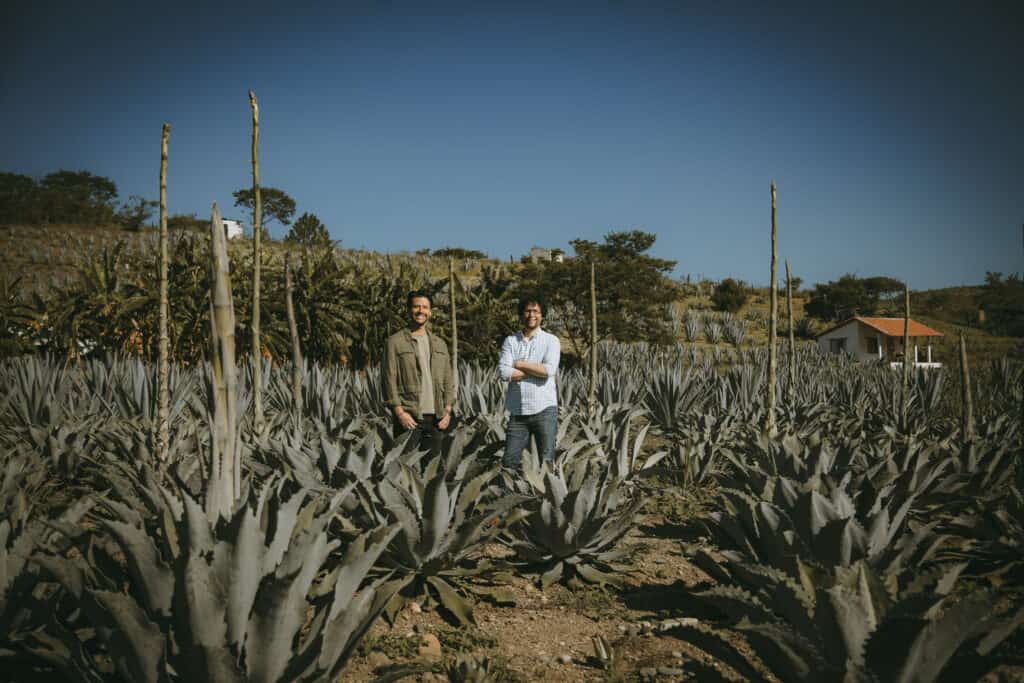
The Siete Misterios project was born in 2008 and launched in 2010, following a trip the brothers made from Oaxaca city to the ocean via the municipality of Sola de Vega located in the Sierra Sur region. This area is known for being the home to the agave variety Tobalá and for clay-pot distilled mezcal.
According to Eduardo Mestre, who is originally from Mexico City, a challenge while developing the brand, was establishing trust. Mestre feels that it was with the support of his family that they were able to gain acceptance in the community. “That definitely took it to another level. ”
Currently his mother Angeles and her partner Eduardo Amador both live at Rancho Concordia in Sola de Vega, where they manage the palenque and work closely with local mezcaleros who visit and work there to produce Siete Misterios.
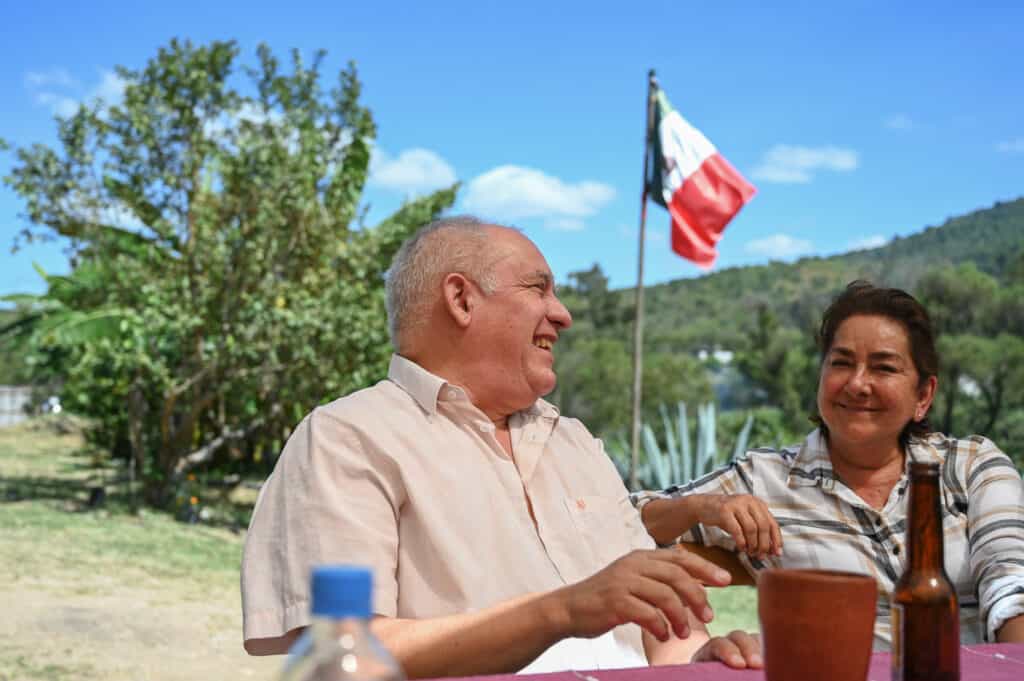
I have traveled to Sola de Vega many times over the years. It’s a beautiful journey, taking the winding road, three hours from Oaxaca, watching the foliage change, as the landscape becomes more tropical and lush.
Previously my adventures to Sola de Vega had been bit hit and miss; often arriving at empty palenques, then traipsing through fields to find the mezcalero I’d been in touch with. I always enjoy earning my mezcal with a bit of a hike, but it’s not always a success. Visiting the home of Siete Misterios was a different kind of experience.
I was traveling with mezcal aficionados Tom Bartam, Jim Wrigley and Brooks Bailey. We arrived through an ornate manicured field of Tobalá, to Rancho Concordia, where we were graciously received. After several hours in a van, we were excited to arrive. Barely catching breath, we launched into our tour of the site with Amador.
Tobalá at the heart of the palenque and brand
We began with the previously mentioned stunning field of Tobalá before working our way up to the palenque itself.
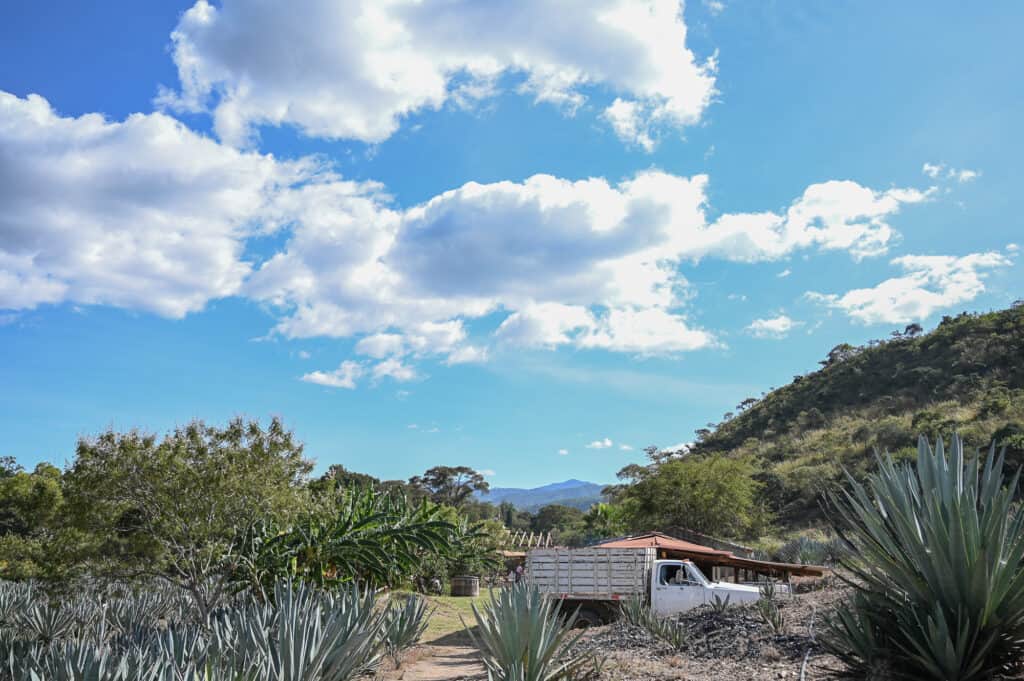
Mestre remembers that the original plan for the land where the Siete Misterios palenque is built was to plant Tobala. This was to counter the irresponsible harvest of wild agaves that had damaged the local numbers of the plant, nearly to the point of extinction. They had heard of the work Luis Mendes was doing cultivating Tobala, which was an inspiring connection at the start of their agave journey.
Describing this expression on the Siete Misterios website, “Tobalá is the jewel in the crown when it comes to mezcals.” This is not only because of its “magnificent physical beauty that resembles the bud of a rose, but due to the experience it offers to all those who have had the fortune of trying it.”
Tobalá (Agave potatorum) is endemic to Sola de Vega. It has a rosette shape and typically produces floral, fruity notes when distilled. It is unusual as it does not reproduce clones, so must be developed from seed.
There are many types, and Amador showed us how much variety emerged from a single field. From small and squat, to big and wild looking with elegant red spines, they are all unique individuals.
Amador guided us through the fields, talking us through the steps they take from seed to mature agave. He said his transition from working as an engineer to working with agave has been an “enriching experience”, especially working with silvestres. He explained that his interest arose from the diversity of cross pollinating agaves, sexually reproducing via seed, “that is, they carry inheritance from different varieties.”
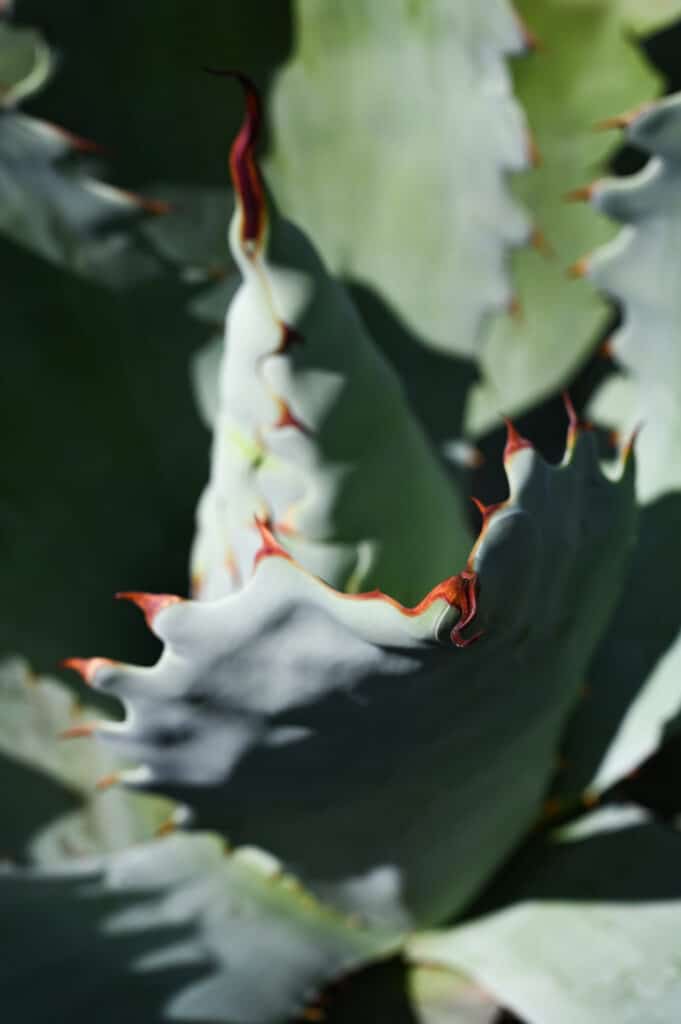
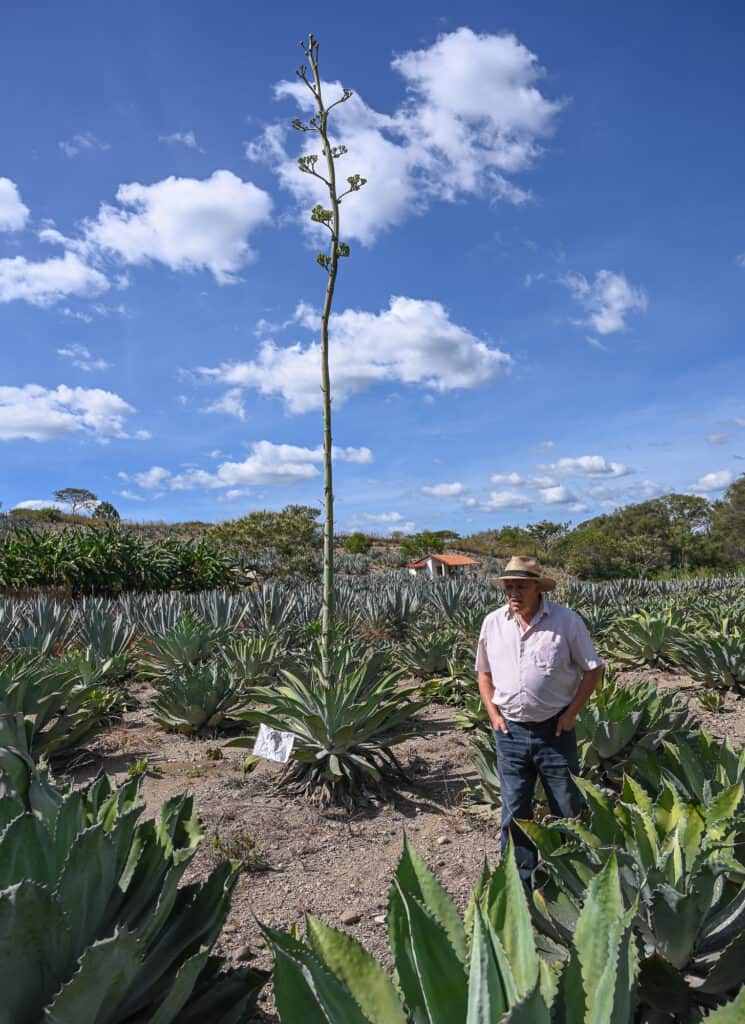
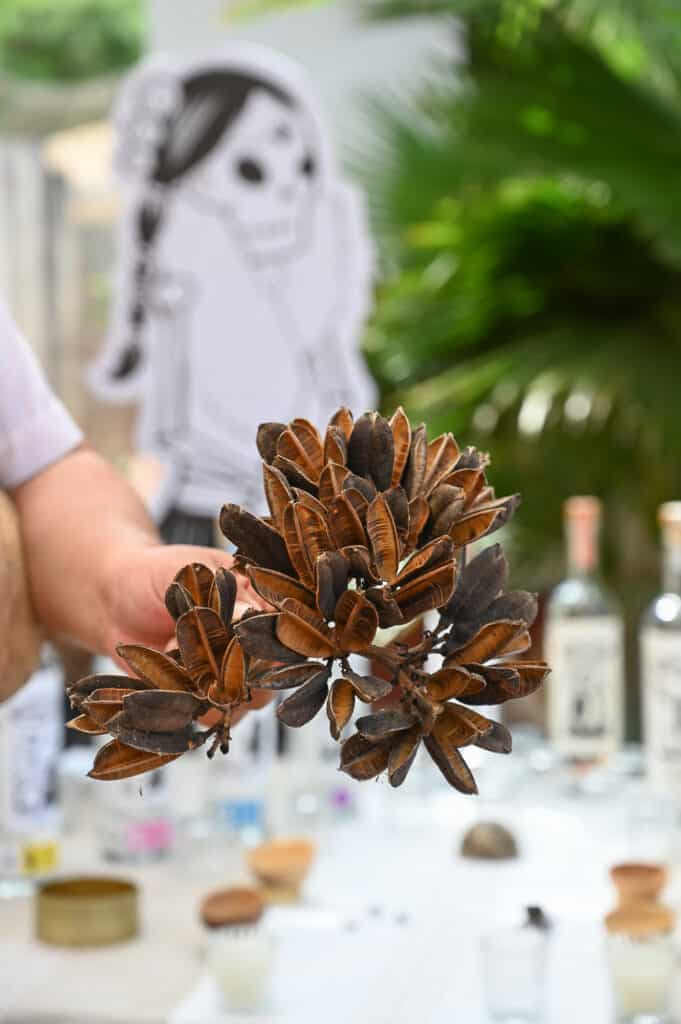
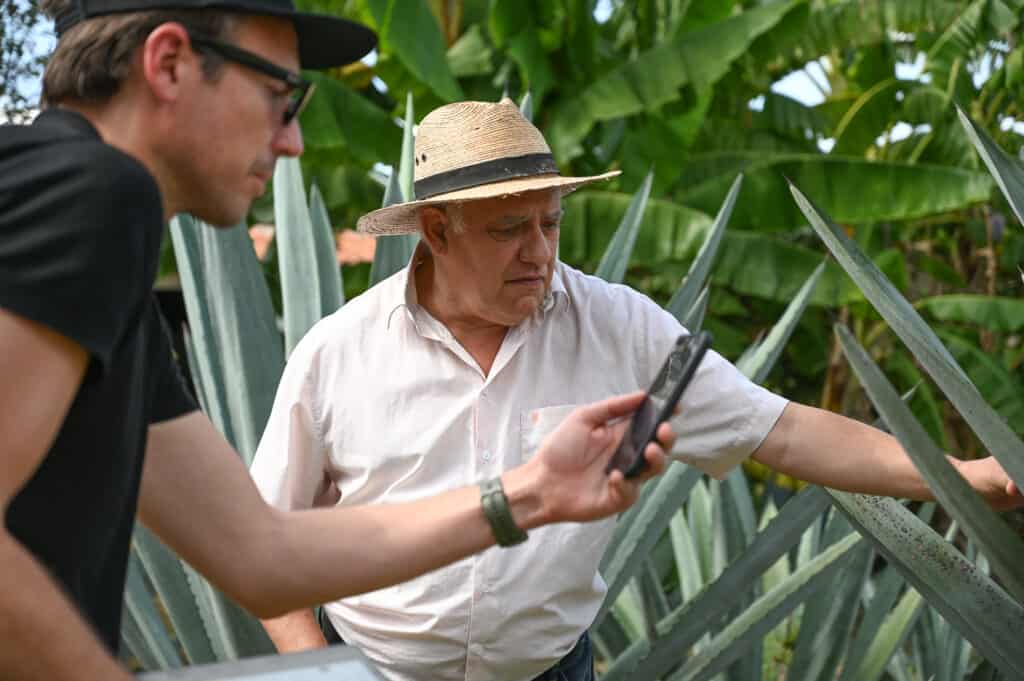
At the Siete Misterios palenque, Amador is also experimenting with growing other species, visiting areas where wild agaves are growing to learn how they interact. He recalls “going to cut wild agaves on a property where there were Karwinskii and Americano varieties. We found three agaves in which their “pineapple”, after being shaved, was shaped like a “pear”. They deduced it was a cross between the two varieties.
After visiting the fields Amador took us to see the palenque. Of course there are elements you would expect to see at a production in Sola de Vega: a pit oven, wooden fermentation vats and a series of small clay pot stills. The oven is brick lined to preserve heat. Mestres described how the tinas are a little bit shorter and wider in order to make it “easier for the yeast to move around. Instead of going up and going down, it is just moving horizontally.”
What I was intrigued by was the dynamic of work in the palenque. While we were there a young mezcalero was running through a practice distillation, distilling colas from a previous batch, to get a better feel for the process.
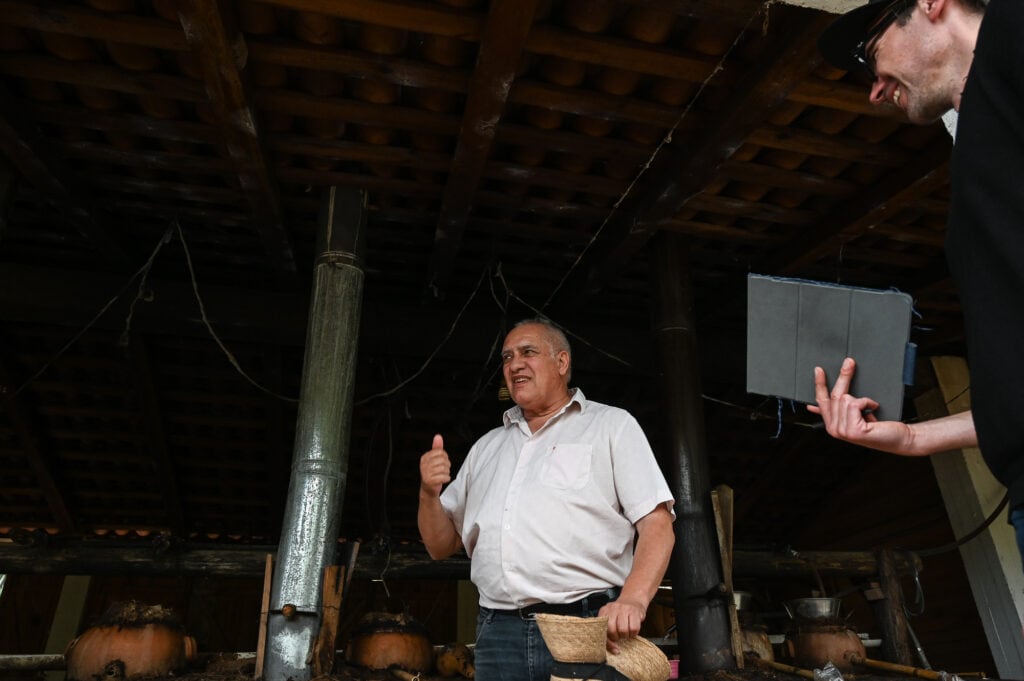
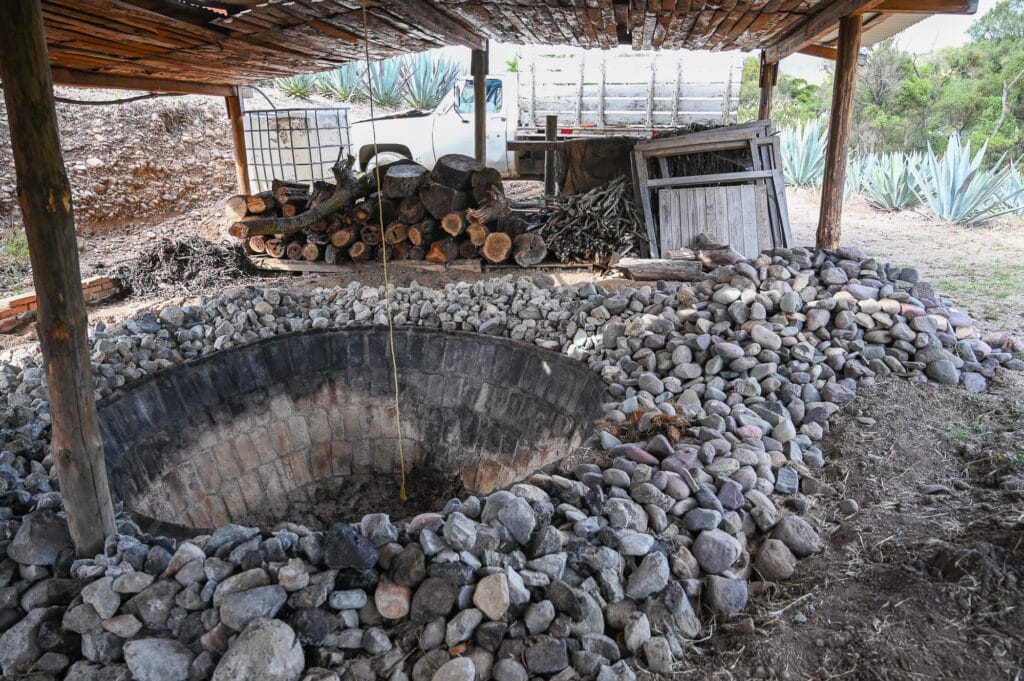
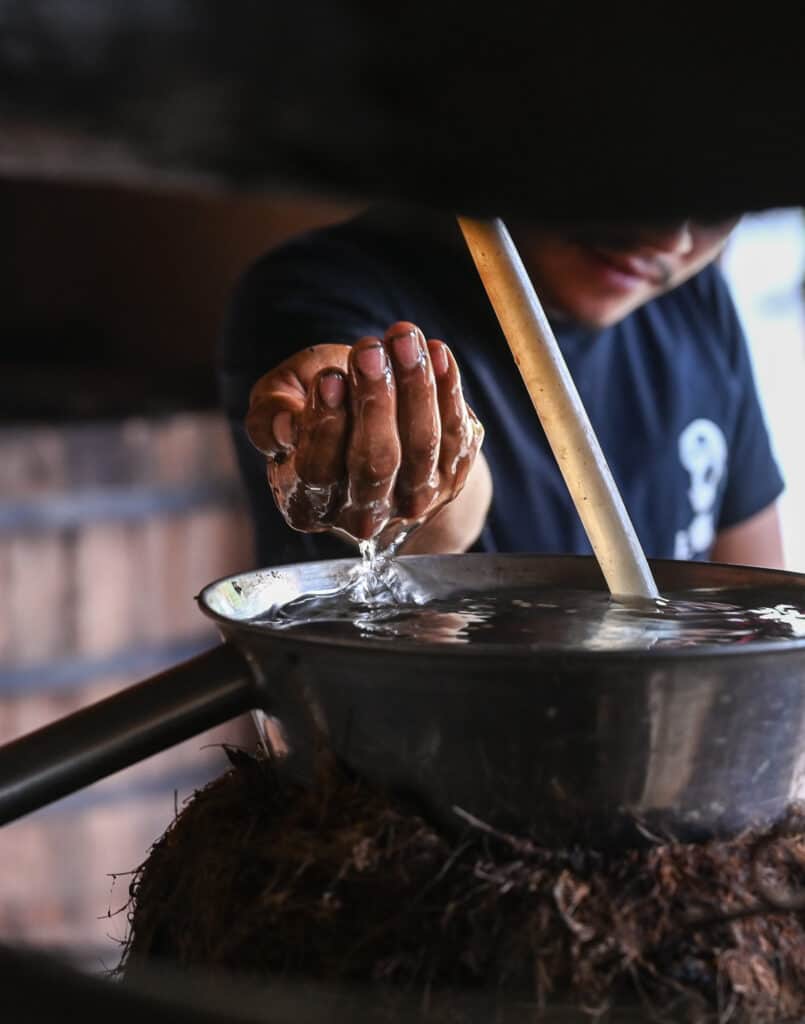
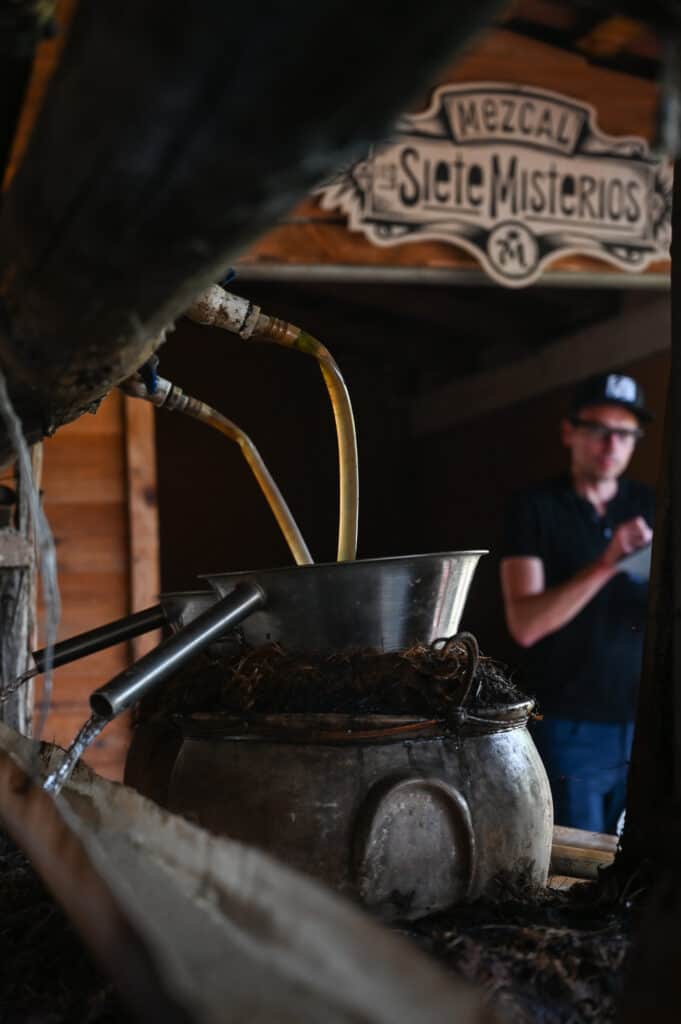
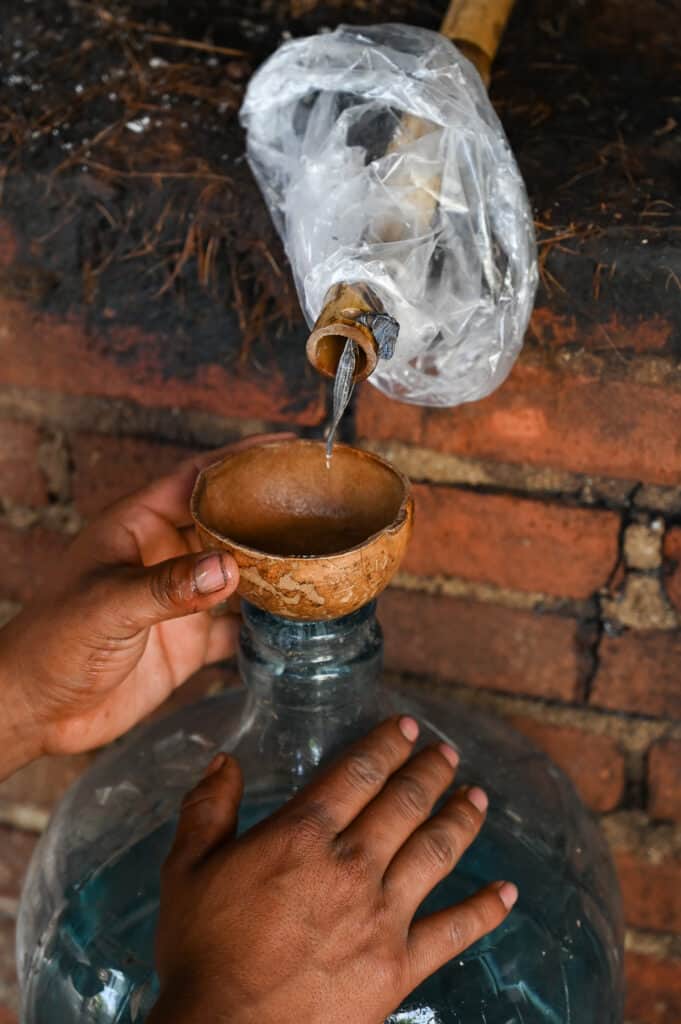
The history of Siete Misterios
Siete Misterios began by working with a collective of different mezcaleros from the region of Sola de Vega. They still work with some of the same mezcaleros they met at the start of their journey, but relationships have evolved. Rather than sourcing the liquid from producers working in their independent palenques, producers work on site in the Siete Misterios palenque. This helps with the sharing of experience, as well as developing a more consistent profile.
Mestre explains that: “It’s an alliance between the mezcaleros and us, in which we pursue to learn the best practices from each mezcalero invited, and then share it with all the other mezcaleros we work with, not only the ones that produces in Rancho Concordia, but all we work with in 5 villages, seeking to elevate the production process through community sharing and learning.”
Alongside the knowledge brought by their contributing mezcaleros, the dynamic at Rancho Concordia has evolved from other influences. For example, visiting academics who have come to the palenque, Amador’s background in engineering, even from the rum industry (the Mestres brothers also have a rum brand, Ron Valdeflores)
A grounding in tradition, while being open to innovation, will help Siete Misterios succeed in this growing, shifting industry. According to Mestre, the key project they are developing further for 2024 is a type of biodigester designed by Amador to process the viñasa, a toxic liquid waste by product, so it can be used safely as a fertilizer.
The biodigestor
Mestre remembers speaking with producers they were working with about the waste elements from the mezcal process. The bagaso or waste fibers for example, “they use it to create a seal between the river rocks and the agave so they don’t get burned,” or use it in the fields. However, the viñasa was mostly getting thrown away. Sometimes this was getting put straight into the river, or sometimes according to Mestre it was being stored in what he describes as a “poltergeist pool. Remember the poltergeist movie?”
“We ask them, hey, what do you do with this waste? And they say; “we just leave it there”.” When he asked why, most producers explained to Mestre that it’s because their “dad used to do it and our grandfather and our great grandfather and so on.”
“So the idea is, okay, “how we can break that pattern of all the mescaleros. Instead of throwing everything in the fields or in the river or in the soil, to start asking questions and to be curious, it’s like, “Okay, this happens, but why does this happen?”
In the past in small productions, this was not an issue, but in light of the growth of mezcal production and the negative impact of discarded viñasa, the Mestres felt that they needed to address this at Siete Misterios.
According to Mestre, the first time he saw something like what they needed was at the Diplomatico rum production in Venezuela in 2016. “And when I visited their facilities, they were telling us about the waste management protocol they have. I was really impressed.” Mestre continued to research the subject and shared details and articles with Amador who further researched different options before finding Dr. Edwin Zelaya and the biodigester he created. They installed it over a month in June 2023.
The prototype is made up of cement tanks and a large plastic bag, which they have to feed daily with viñasa. Mestre describes it as a “living ecosystem. If we stop feeding it, then all the bacteria and everything that lowers the pH and transforms that really acidic liquid into fertilizer, is going to die. So every day we have to pour a minimum of 160 liters into the bio digester.”
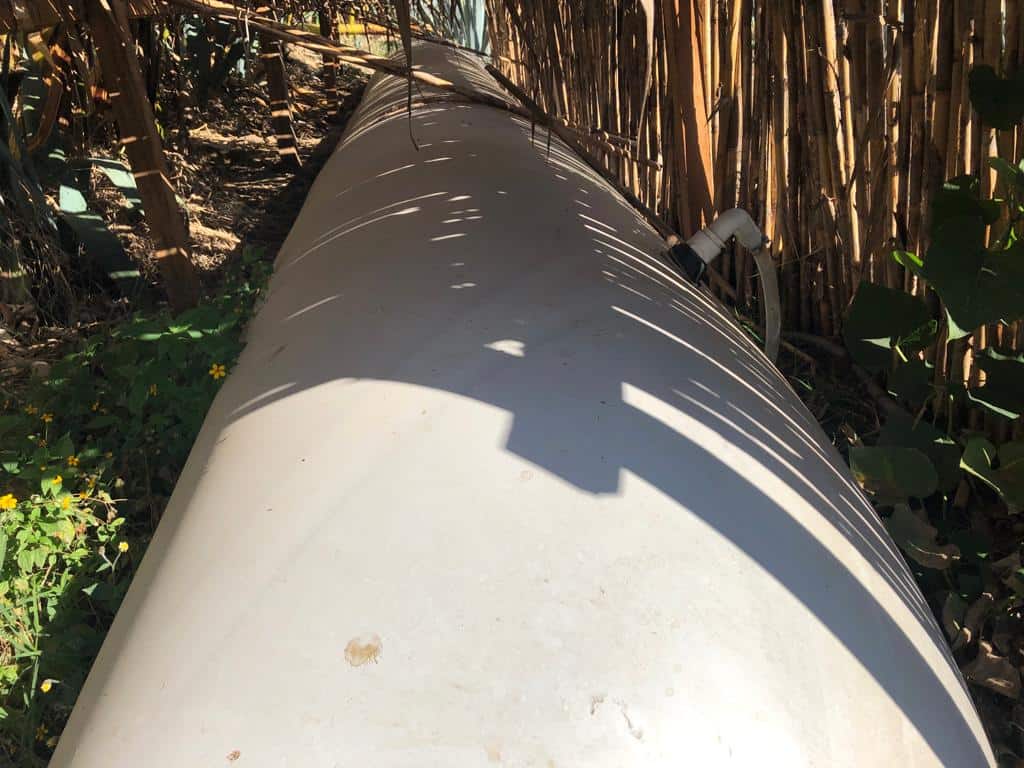
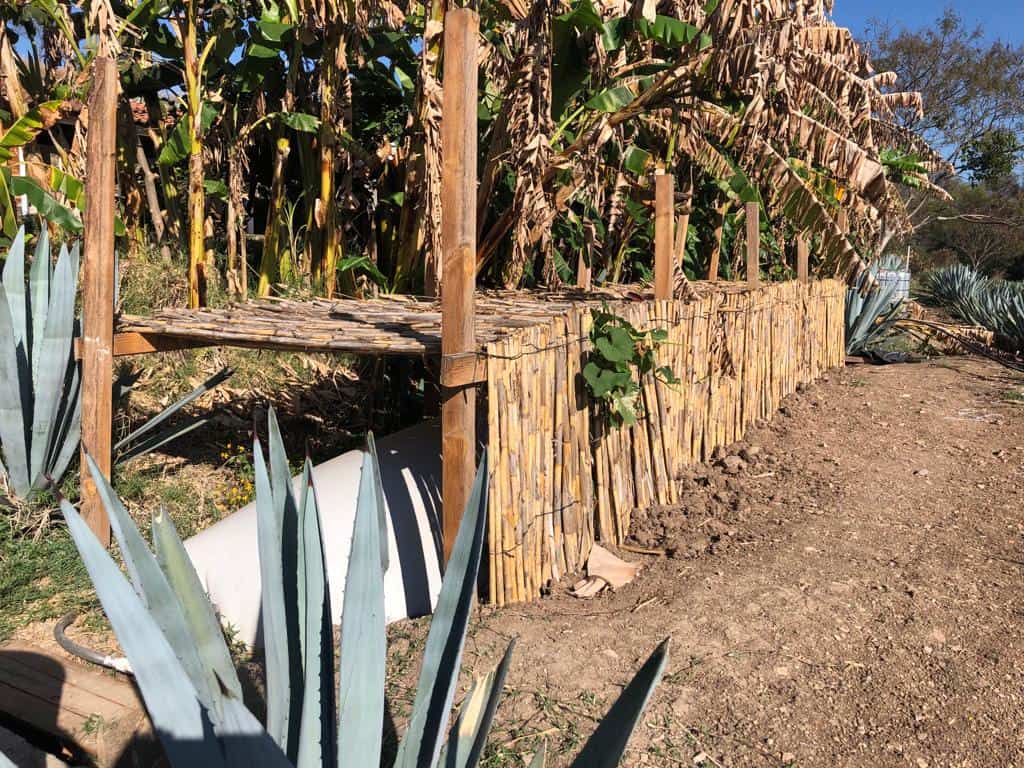
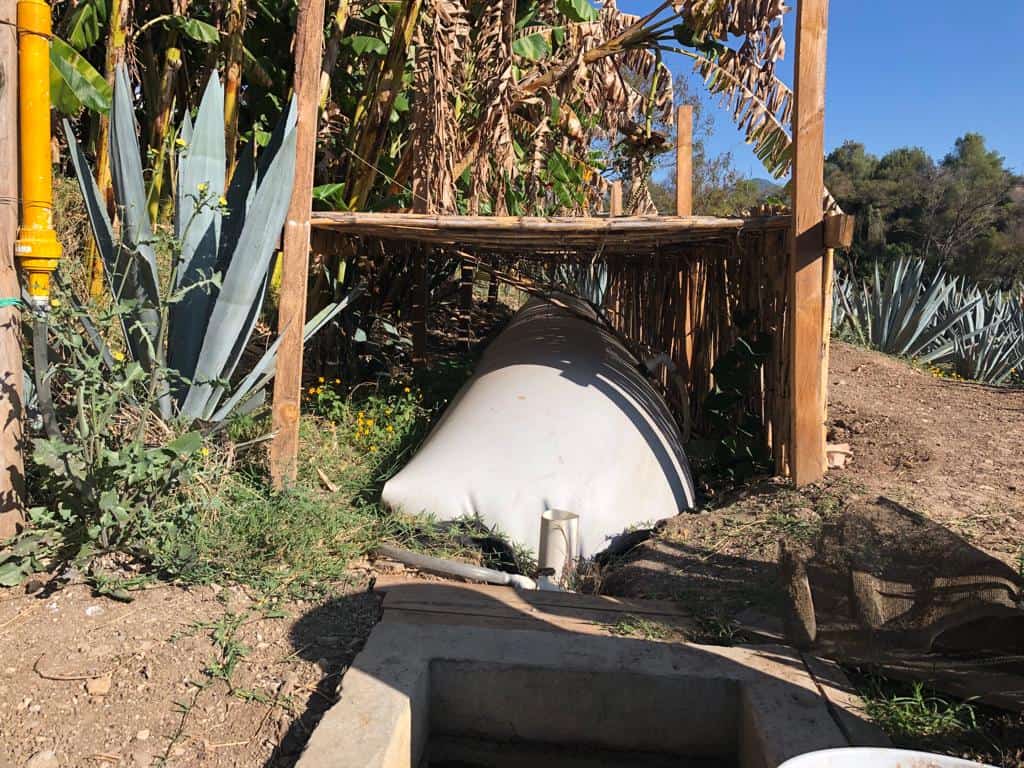
The viñasa takes from 45 to 60 days to transform, developing two sub products. One is a methane gas that they use for cooking. Mestre says that they “want to do some research to see what would happen if we start the distillation with that same gas and we eliminate the wood factor from there.” The second product is liquid fertilizer that they use in the fields.
Mestre’s goal “is to give it to agriculturists and start to use it on tomatoes, corn and other crops. That doesn’t have to do with agaves. But I think that the first stage is to see how it works, how it develops, and how high is the maintenance in labor.”
The next step for Mestre, Amador and the biodigester will be to see how receptive the local producers are to working with this new equipment. “Something that we have learned is that you cannot impose anything in Oaxaca. Everything has to be really organic, and people have to come and ask you. It’s not something that we want to keep for ourselves. It’s something that we really want to share. But the challenge, I think, is that people need to be open.”
The aim is for local producers to eventually have their own biodigesters. Mestre says that “instead of going and trying to micromanage and tell them what to do, you invite them to come and see. You can have this friendly ecosystem.” He wants to help people come to the conclusion that, in the end, “it’s for the benefit of you and for the benefit of the environment, definitely.”
Looking toward growth
Whether it is domesticating Tobalá or developing solutions to industry waste, the Siete Misterios family are invested in preserving tradition while securing the future of mezcal. Mestres says that their “ motto is to preserve and maintain all the traditional manners on how mezcal is made and how it is consumed in each region.”
However, as the market demanded more of the spirit, the future of their brand required growth. It was not feasible to grow a small batch, clay pot, and specifically wild agave concept. This led to the copper still expression, the Doba Yej. The name means Espadin in Zapotec to distinguish it from the Espadin they have in their original clay pot range.
Mestre says, “we launched Doba Yej, because of the same scarcity of the agaves and the clay pot installation.” They did not want to put pressure on the local producers to change their methods to sustain this growth, so they developed this new line. They work with three different producers from three different towns to produce the Doba Yej, Santiago Matatlan, San Dionisio Ocotepec and Yautepec.
According to Mestre, with the Doba Yej range they were aiming for a mezcal “that is super balanced, which you can drink neat, tasting like a traditional, artisanal mezcal.” The Doba Yej is 44% which is on the higher end for a well mezcal. This is because they also want it to work for the cocktail industry, so that “it wouldn’t lose or get lost with the other ingredients. The idea with the Doba Yej is to have it all.”
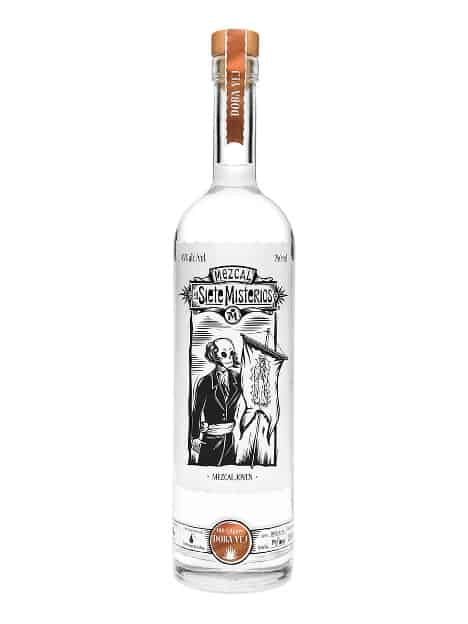
Developing a label that tells a story
Siete Misterios has an iconic aesthetic that connects the whole range, from the first clay pot expressions to the Doba Yej. This is the skeletal family illustrating a sort of mythological story the Mestres brothers created for the brand on its labels. This skeletal family, led by a character called Porfirio, was inspired by the etchings of 19th century Mexican artist, José Guadalupe Posada. Ahead of trying the mezcal itself, Mestres hoped for these drawings to evoke Mexico for those far from home.
The story Mestre wrote about Porfirio is about a man from Tequila:
“Following some kind of crime he was forced to leave his home, and for a time he wandered the country until he got to Sola de Vega, in Oaxaca. There he starts to see plants really similar to the agave he knew from his hometown. When he got closer to a distillery, he smelled the smoke and cooked agave, which is when he decided to stay in the town and to learn more about it. He met two sisters, the mezcalero and some other characters that guide him through a mezcal experience. This journey through mezcal helps him reconnect with his roots.”
Mestre hopes that Siete Misterios “tastes like the mezcal you drink in the plastic bottle when you go to Oaxaca (fresh from a palenque). So having that in mind, when you’re homesick and you want something that really tastes like your home or something, you look for that. When a Mexican sees “a bottle of Siete Misterios in a different country, they will be transported back to Mexico.”
It is Porfirio’s story we find on the labels for the claypot expressions. The Doba Yej varieties show a similar style illustration, but the characters represent three heroes of Mexican Independence. Josefa Ortiz Dominguez, Don Miguel Hidalgo and Jose Maria Morelos. They represent the three different villages producing for this range.
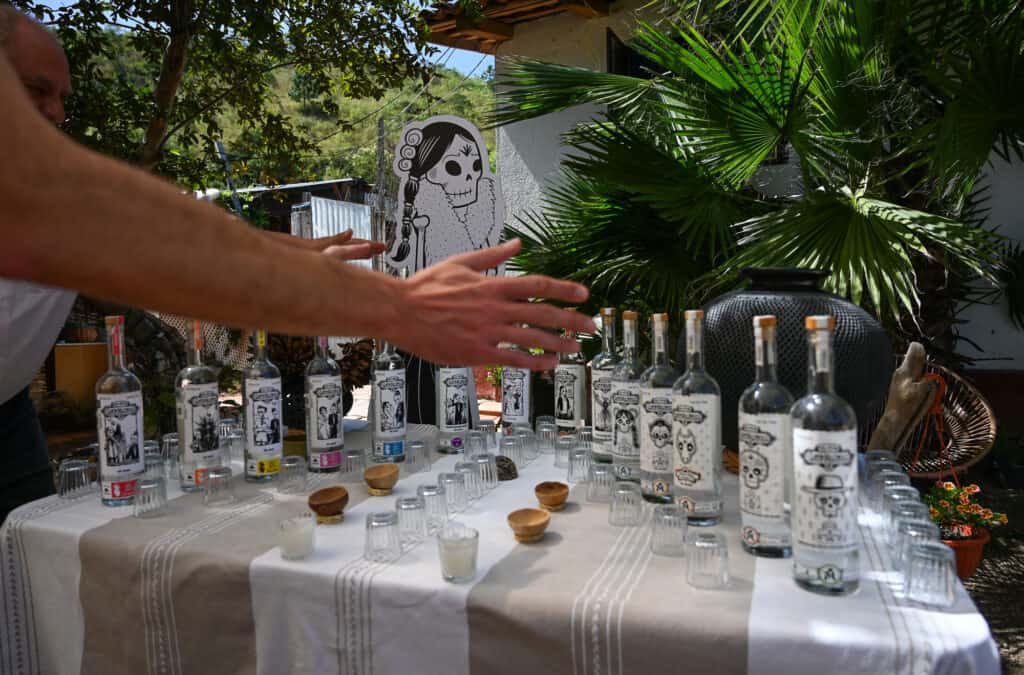
Eyes on the future
As well as continuing to innovate and develop projects such as the biodigester, Mestre says the goal for 2024 is to “keep growing. That’s something that we love to do. Not just the economical income, but also as a team. We can learn and grow as a family.”
Lately the family has become part of a larger community as the brothers have partnered with Michters. Michter’s parent company Chatham House has a 50% stake in the brand. The Mestre brothers still manage production and Mexican distribution.
The partnership began In 2021 with Chatham becoming the exclusive global sales and marketing agent for Los Siete Misterios, excluding Mexico. Following the partnership, Siete Misterios has seen healthy growth – distributing to 25 markets – with the Doba Yej making up approximately seventy percent of sales.
Speaking to CLASS, the brothers said the focus would remain on traditional mezcal but improvements would be made to increase the yield. “We want to introduce new ways of working at our distillery as a model we can apply to the producers we work with so they can make the best mezcal possible,” said Eduardo Mestre. “This will enable us to focus on production – Chatham will be our sales and marketing muscle worldwide.”
Updated January 19th, 2024 to include the name Dr. Edwin Zelaya who developed the biodigester.


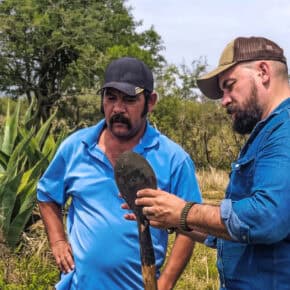
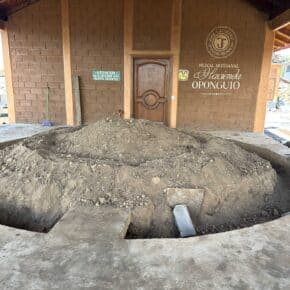








Leave a Comment